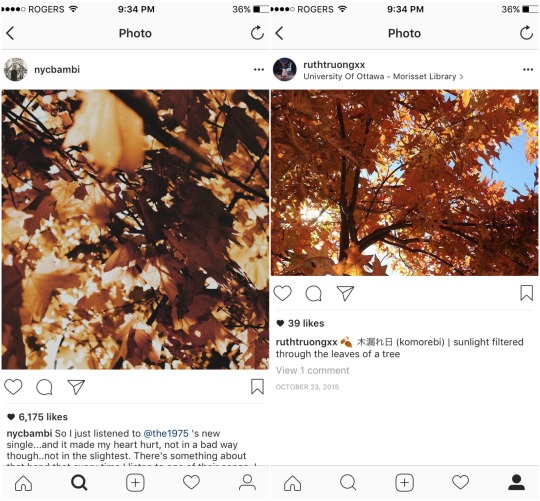Don't wanna be here? Send us removal request.
Text
Who’s In Control? (Final)
To what degree do I control my use of social media and my self-representation online? To what extent has it controlled me? In her TED talk, Ulrike Schultze describes the “Human-Technology Entanglement” as “a co-constitutive kind of relationship … [wherein] we become what the technology allows us to become.”
#chasingreflections
I’ve long held on to some notion of an “ideal me”, but I’ve also long been aware of my inaction as an obstacle – hence the blog title, Work in Progress. This ideal has been shaped by observing others’ online identities as well as my own. Northwestern CTD’s blog post “The Self in Selfie” posits that “differences between our ‘real’ and online identities can shape not only how others perceive us but our self-perceptions, creating pressure to be more like the often idealized digital versions of ourselves and our peers.”

Above: a post inspired by one I had seen by @nycbambi a year before.
My giving into said pressure is evidenced in some Instagram posts that I made based on other people’s posts that I wished to emulate, and even in my behaviour as a consumer.
#IN$PIRATION
Peter Roesler’s Business Journals article cites a Deloitte report which “found that 47 percent of millennials are influenced in their purchases by social media.” My shifting personal interests and interactions with social media accounts have certainly been reflected in past purchases:
Beauty: buying makeup, a lot of which was infrequently or never used
Clean Eating: collecting recipes and filling my pantry with “health-nut” staples like organic apple cider vinegar and hemp hearts. (Confession: I’m still using chia seeds I bought 3 years ago.)
Fitness: Along with clean eating, I gave into an Instagram promotion by Alexa Jean Fitness to purchase her bundle of fitness programs at 75% off. The PDFs are sitting in my Dropbox. (Exercises I’ve attempted since my purchase: 0)
#picsoritdidnthappen
I am undeniably guilty of making my friends wait to start eating their food so that I can take a photo of our meal. Tim Highfield and Tama Leaver’s “Instagrammatics and Digital Methods” cites Susan Sontag’s statement that photography is “‘one of the principle devices for experiencing something, for giving an appearance of participation’” (48).
This evidence of participation can be community-building, but the need for it has occasionally impinged on my ability to simply enjoy life’s sweet or funny moments.

A notable example: I went hiking with a group of friends, and to save on data charges, I allowed my snaps to fail to post to my Story, intending to try posting the preserved posts again later (This was before Snapchat allowed you to post from your Camera Roll). When I finally got wifi access, I found that the snaps had disappeared. Even though I had other media to post, like the photo above, I was still upset that the other moments were lost.
#nofilter?
Highfield and Leaver highlight the importance of the visual in self-representation, and they argue that “the visual aesthetics of social media can complicate attempts to … determine ‘authenticity’. Questions of self-representation, of performance and of the authentic/inauthentic self are ongoing concerns for social media research” (52).
The visual is a powerful tool in self-representation that I have used it on social media to compensate for my feelings of inadequacy. Who I am online doesn’t have to reflect who I am in real life. Realizing this produced a compulsion to continually produce visuals that conveyed a certain idea of my identity.
#doitforthegram
There is a certain power in projecting an image of yourself that may appear more put together than your authentic self, but looking back, there is also some delusion to it. How far was I willing to go to produce such deceitful visuals?

Contrary to the caption, there is no coffee in that cup. Only the nails on my left hand were painted specifically for the photo. I downloaded an app in order to access a self-timer for my iPhone 5 camera in order to take this. (In accordance with the caption, however, I am indeed a klutz.)
#iamwhoiam?
In Chapter 1 of Seeing Ourselves Through Technology, Rettberg points out that “the ease … of deleting digital images and taking new ones allows us to control the way we are represented to a far greater degree” (12). On Instagram, I prioritized maintaining an aesthetic feed, which sometimes meant deleting selected past photos from my account. I took it even further by creating an album in my iPhone photo library wherein I could experiment with the order and placement of potential posts before putting them online.

#selfcontrol
According to a video by ASAP Science, “5-10% of internet users are actually unable to control how much time they spend online.” Unsurprisingly, while I try to control the representation of my “self” through social media, in my use of it, I have a severe lack of self-control. To tackle my compulsion to check social media and my trouble focusing on schoolwork, I have tried various tactics, from small to drastic:
Deactivated Facebook temporarily
Asked someone to change my passwords
Deleted apps from phone
Purchased Pomodoro app to try the Pomodoro technique
Downloaded Self Control for Mac to blacklist websites for a set amount of time
The last two are the only ones that ever worked, and I still use them sometimes, but even they are not foolproof.
But even on social media, my focus is limited. Writing and Editing for Digital Media points out that “people interacting with digital media aren’t … reading as [reading] has been traditionally understood” (34). This is true: I often give up on reading an article or post online if I find it is too long.
#memeandyou
Widespread Internet meme culture is now purportedly said to contribute to building connections and strengthening bonds with others. I think this is because memes allow us to recognize shared experiences, feelings, and interests. “Humans are uniquely individualized … but when their interests are joined, or one perceives or is persuaded to believe that they are joined, then identification occurs.” (Writing and Editing for Digital Media, 37) How many of us have shared memes with friends attaching a message or comment like, “Me right now,” or “So relevant, I can’t”?
The sense of community is heightened when memes use references that I can identify. As Highland and Leaver write, “additional levels of meaning or significance may also be apparent to those who are familiar with the relevant source texts” (53). I appreciate being able to recognize a moment from The Office applied to a new context, for example.

I’m not incapable of making connections through conversation, but I can’t deny that sharing and commenting on memes have become a significant part of my socialization online.
#cantstopwontstop
I must concede with The Guardian’s Tomas Chamorro-Premuzic’s observation that “online activities are no longer separable from our real lives, but an integral part of it.” Although I’ve given up on maintaining a certain idea of myself on Instagram, it’s clear that social media has dominated my life in numerous ways and to varying degrees.
At present, I’ve given up trying so hard to control my identity on social media. I’m more inclined to observe and to privately share content on social media. In other words, it probably controls me more than I control it.
But you know what? I ain’t even mad.
BIBLIOGRAPHY
“Here I go again.” Stream de la meme, Facebook, 23 Mar 2017, https://www.facebook.com/Streamdelameme/photos/a.623662911114554.1073741828.623660944448084/814130572067786/.
“The Self in Selfie: Identity in the Age of Social Media.” Northwestern CTD (blog), Northwestern University Center for Talent Development, https://www.ctd.northwestern.edu/blog/self-selfie-identity-age-social-media. Accessed 25 Feb 2017.
Carroll, Brian. “Writing for Digital Media.” Writing and Editing for Digital Media, 2nd ed. Routledge, 2014.
Chamorro-Premuzic, Tomas. “How different are your online and offline personalities?” The Guardian, 24 Sept 2015, https://www.theguardian.com/media-network/2015/sep/24/online-offline-personality-digital-identity. Accessed 25 Feb 2017.
Highfield, Tim and Tama Leaver. “Instagrammatics and digital methods: studying visual social media, from selfies and GIFS to memes and emoji.” Communication Research and Practice 2.1 (2016): 47-62. Taylor and Francis. Accessed 27 Feb 2017.
Moffit, Mitchell and Gregory Brown. “5 Crazy Ways Social Media Is Changing Your Brain Right Now.” Youtube, uploaded by AsapSCIENCE, 7 Sept 2014, https://www.youtube.com/watch?v=HffWFd_6bJ0.
Rettberg, Jill Walker. “Written, Visual and Quantitative Self-Representations.” Seeing Ourselves Through Technology: How we Use Selfies, Blogs and Wearable Devices to See and Shape Ourselves. Palgrave Macmillan, 2014. pp. 1-19.
Roesler, Peter. “How social media influences consumer buying decisions.” The Business Journals, 29 May 2015, http://www.bizjournals.com/bizjournals/how-to/marketing/2015/05/how-social-media-influences-consumer-buying.html. Accessed 20 Mar 2017.
Schultz, Ulrike. “How Social Media Shapes Identity.” TEDxSMU, April 2015, https://www.youtube.com/watch?v=CSpyZor-Byk.
Tyler, Christie (nycbambi). “So I listened to @the1975 ‘s new single...” Instagram, 30 Oct. 2014, https://www.instagram.com/p/uym79aplT3/.
0 notes
Text
Who’s In Control (Rough Draft)
To what degree do I control my use of social media and my self-representation online? To what extent has it controlled me? In her TED talk, Ulrike Schultze describes the “Human-Technology Entanglement” in terms of “a co-constitutive kind of relationship … [wherein] we become what the technology allows us to become.”
#chasingreflections
I’ve long held on to some notion of an “ideal me”, but I’ve also long been aware of my inaction as an obstacle – hence the blog title, Work in Progress. This ideal has been shaped by observing others’ online identities as well as my own. Northwestern CTD’s blog post “The Self in Selfie” posits that “differences between our ‘real’ and online identities can shape not only how others perceive us but our self-perceptions, creating pressure to be more like the often idealized digital versions of ourselves and our peers.”
My giving into said pressure is evidenced in some Instagram posts that I made based on other people’s posts that I wished to emulate (below), and in even in my behaviour as a consumer.
(photo 1)
#IN$PIRATION
Peter Roesler’s Business Journals article cites a Deloitte report which “found that 47 percent of millennials are influenced in their purchases by social media.” My shifting personal interests and interactions with social media accounts have certainly been reflected in past purchases:
- Beauty: buying makeup, a lot of which was infrequently or never used
- Clean Eating: collecting recipes and filling my pantry with “health-nut” staples like organic apple cider vinegar and hemp hearts.
o Confession: I’m still using chia seeds I bought 3 years ago.
- Fitness: Along with clean eating, I gave into an Instagram promotion by Alexa Jean Fitness to purchase her bundle of fitness programs at 75% off. The PDFs are sitting in my Dropbox.
o Exercises I’ve attempted since my purchase: 0
#picsoritdidnthappen?
I am undeniably guilty of making my friends wait to start eating their food so that I can take a photo of our meal. Tim Highfield and Tama Leaver’s “Instagrammatics and Digital Methods” cites Susan Sontag’s statement that photography is “‘one of the principle devices for experiencing something, for giving an appearance of participation.’”
This evidence of participation can be community-building, but the need to it has occasionally impinged on my ability to simply enjoy life’s sweet or funny moments.
(photo)
A notable example: I went hiking with a group of friends, and to save on data charges, I allowed my snaps to fail to post to my Story, intending to try posting the preserved posts again later (This was before Snapchat allowed you to post from your Camera Roll). When I finally got wifi access, I found that the snaps had disappeared. Even though I had other media to post, like this photo, I was still upset that the other moments were lost.
#nofilter?
Highfield and Leaver highlight the importance of the visual in self-representation, and they argue that “the visual aesthetics of social media can complicate attempts to … determine ‘authenticity’. Questions of self-representation of performance and the authentic/inauthentic self are ongoing concerns for social media research” (x).
The visual is a powerful tool in self-representation that I have used it on social media to compensate for my feelings of inadequacy. Who I am online doesn’t have to reflect who I am in real life. Realizing this produced a compulsion to continually produce visuals that conveyed a certain idea of my identity
#doitforthegram
There is a certain power in projecting an image of yourself that may appear more put together than your authentic self, but looking back, there is also some delusion in it. How far was I willing to go to produce such deceitful visuals?
(photo)
Contrary to the caption, there is no coffee in that cup. Only the nails on my left hand were painted specifically for the photo. I downloaded an app in order to access a self-timer for my iPhone 5 camera in order to take this. (In accordance with the caption, however, I am indeed a klutz.)
I am who I am?
In Chapter 1 of Seeing Ourselves Through Technology, Rettberg points out that “the ease … of deleting digital images and taking new ones allows us to control the way we are represented to a far greater degree.” On Instagram, I prioritized maintaining an aesthetic feed, which sometimes meant deleting selected past photos from my account. I took it even further by creating an album in my iPhone photo library wherein I could experiment with the order and placement of potential posts before putting them online.
(photo)
#selfcontrol
Unsurprisingly, while I try to control the representation of my “self” through social media, in my use of it, I have a severe lack of self-control. To tackle my compulsion to check social media and my trouble focusing on schoolwork, I have tried various tactics, from small to drastic:
Deactivated Facebook temporarily
Asked someone to change my passwords
Deleted apps from phone
Purchased Pomodoro app to try the Pomodoro method
Downloaded Self Control for Mac to blacklist websites for a set amount of time
(photo)
The last two are the only ones that ever worked, and I still use them sometimes, but even they are not foolproof.
But even on social media, my focus is limited. Writing and Editing for Digital Media points out that “people interacting with digital media aren’t ... reading as [reading] has been traditionally understood” (x). This is true: I often give up on reading an article or post online if I find it is too long.
#memeandyou
The widespread Internet meme culture is now purportedly said to contribute to building connections and strengthening bonds with others. I think this is because memes allow us to recognize shared experiences, feelings, and interests. “Humans are uniquely individualized … but when their interests are joined, or one perceives or is persuaded to believe that they are joined, then identification occurs.” (Writing for Digital Media) How many of us have shared memes with friends attaching a message or comment like, “Me right now,” or “So relevant, I can’t”?
The sense of community is heightened when memes use references that I can identify. As Highland and Leaver write, “additional levels of meaning or significance may also be apparent to those who are familiar with the relevant source texts” (x). I appreciate being able to recognizing a moment from The Office applied to a new context, for example. I’m not incapable of making connections through conversation, but I can’t deny that sharing and commenting on memes have become a significant part of my socialization online.
Bibliography
(To be written, links and images to be added)
0 notes
Text
Group #12 Presentation Proposal
Student Names: Jamie-Lee Lauzon, Laura Molinaro, Ruth Truong
Professor Moreland
ENG 3170 Writing for Digital Media
March 5, 2017
Group Presentation Proposal: GROUP #12
Presenting on March 16, 2017, our group will respond to the reading “Here be Monsters: a Choreomaniac's Companion to the Danse Macabre.” We will take an exploratory approach to the subject matter, with each of our presentations investigating chosen frameworks and key concepts discussed in the article including: creepypasta, digital engagement, post-structuralism, feminism and queer theory.
Presenter 1: Jamie-Lee Lauzon - 7259012
Title: Search for monsters
I will introduce creepypasta and its origin, with the example of smile.jpg that is included in our reading. I will discuss Henricksen idea of creepypasta, that “there is no possibility of remaining untouched’’. We can’t separate ourselves from it as much as we want to keep it at an arm's length. I will explore then Harraway arguments of “God's Trick” that refuse to accept objectivity as a kind of disembodied, transcendent gaze. I will connect those idea with the thriller Shutter Island that blurs the line between reality and fiction. It plays with “real” and “authentic” since we are looking for proof in the form of diaries, witness statements, articles, very much like a creepypasta does. I will focus on the idea that by looking for these monsters, we are allowing them to enter our “meatspace”.
Presenter 2: Laura Molinaro - 7289310
Title: Abject Androids
For my part of the assignment I will be discussing Post-structuralist theories in connection to HBO’s Westworld. I will mainly focus on the character Bernard who is the Head of the Westworld Programming division who ultimately, he comes to learn that he is a host himself. This moment of realization calls into question the separateness of several binaries, namely, virtuality and reality, man and machine, as well as, human and artificial consciousness. I’ll tie this back to the theme of horror by speaking of the “Uncanny Valley” phenomenon and how it connects to abjection; a topic post-structuralist Julia Kristeva attributes to the threatening breakdown of meaning caused by blurring the distinctions between subject and object or between self and other. I’ll connect Kristeva’s concepts in order to create a psychoanalytical framework for understanding the appeal of creepypasta.
Presenter 3: Ruth Truong - 7394116
Title: Creating Space for the Dispossessed
For my part of the presentation I will be citing Henriksen’s use of Derrida’s criticism, and the inherent contradictions in the notions about women not having a fixed place and in the constraints that have limited and continue to limit “movement” for women. I will be analyzing Jonathan Swift’s poem “The Lady’s Dressing Room” to examine the historical constraints on women and the alignment of women and monsters as it applies to facing women’s physicality and also to women challenging the status quo. I will then shift to examining the convergence of woman and monster in the femme fatale figure of Amy Dunne in the 2014 film Gone Girl, and the contradictions at play as she demonstrates her lack of a “fixed position” by shifting from a denial of her “Cool Girl” role to a return to the performance of an ideal marriage. Finally, I will look at a more mild and current example, namely the recent controversy over Emma Watson’s Vanity Fair shoot that resulted in anti-feminist accusations. To conclude, I will shift Henriksen’s invitation to search for monsters to open an invitation to allow for the “dance of relating,” to make space for the movement of fluid identities and narratives, particularly of those “dispossessed of a place from whence to speak,” which includes not only women but the LGBTQ community, for example.
Creative Component
For our creative component we will be recreating the Smile Dog Creepypasta. We will rework and condense the narrative and incorporate audio-visual components to create a compelling take on the original story.
Slideshow can be accessed here.
0 notes
Text
Final Project Pitch


I decided to create this generalized Evil Kermit/”inner me” meme to encapsulate what its reproductions tend to convey: a set of statements or impulses that are contradictory or counterproductive, sometimes with a hint of fatalism. In my blog-style reflection, I’ll be examining the contradiction, or the push-and-pull, of trying to exert or gain control over the identity I have tried to project on social media while being subject to the control of social media.
Abstract
I will be doing a blog post reflecting on some ways in which my life has been affected by digital media, primarily social media. Organized categorically, the post will examine such things as (1) effects on personal identity and self-perception (both online and offline), (2) the psychological repercussions of addiction to digital media, and the measures I have taken to try to combat that addiction, (3) and the way I socialize and find a sense of belonging with others online. It may also expand to include other topics. The section on identity will include the extent to which I am subject to a compulsion to emulate what I observe and like, in the visual media I create and in my consumer choices and (often hopeful but unfulfilled) ideals and goals. I am also subject to finding validation in recognizing source texts of recycled visuals like reaction GIFs across social media platforms, as Highland and Leaver note in “Instagrammatics and digital methods: studying social media, from selfies and GIFs to memes and emoji.” I will also be citing this article to evaluate the importance of the visual in my attempts to gain control in shaping my identity, the lengths I have gone to in order to create those visuals, and the levels of authenticity or artificiality regarding my online self and my “real” self. In analyzing the ways I control my self-representation and require responses from others, as well as how I am prone to read others’ self-representations as texts in my socialization with others, I will make reference to Rettberg’s “Written, Visual and Quantitative Self-Representations.” I am planning to include examples of past posts with captions that reveal the level of authenticity, the effort put into creating the visual, and whether my real self/life reflect those images to any degree.
0 notes
Text
Seeing YourSelf(ie)

Ruth Truong was originally from Ottawa, and though her family relocated in 2006, she chose to return for university. She has loved reconnecting with the people, food, and celebration of culture that the city offers. She particularly enjoys eating at local joints and watching and discussing films at the Bytowne with a dependable movie buddy. While she appreciates good art films, Ruth is also fond of good comedy, whether it be stand-up, sitcoms, or talk shows. Generally, she values art and comedy for their ability to unify people and to give a voice to light and serious themes and issues.
Ruth is studying English and is in her fourth year at the University of Ottawa, where she has had the privilege to participate in two digital humanities projects, under Dr. Irene Makaryk’s direction, to celebrate Shakespeare’s influence in Canada. Having switched to English following her first year in science, she plans to take another year to complete her program. After graduating, she may pursue a college certificate to establish a profession in the English field, such as editing. Though her direction is unclear, she is making the most of her current place in life and continually aiming to improve herself.
1 note
·
View note